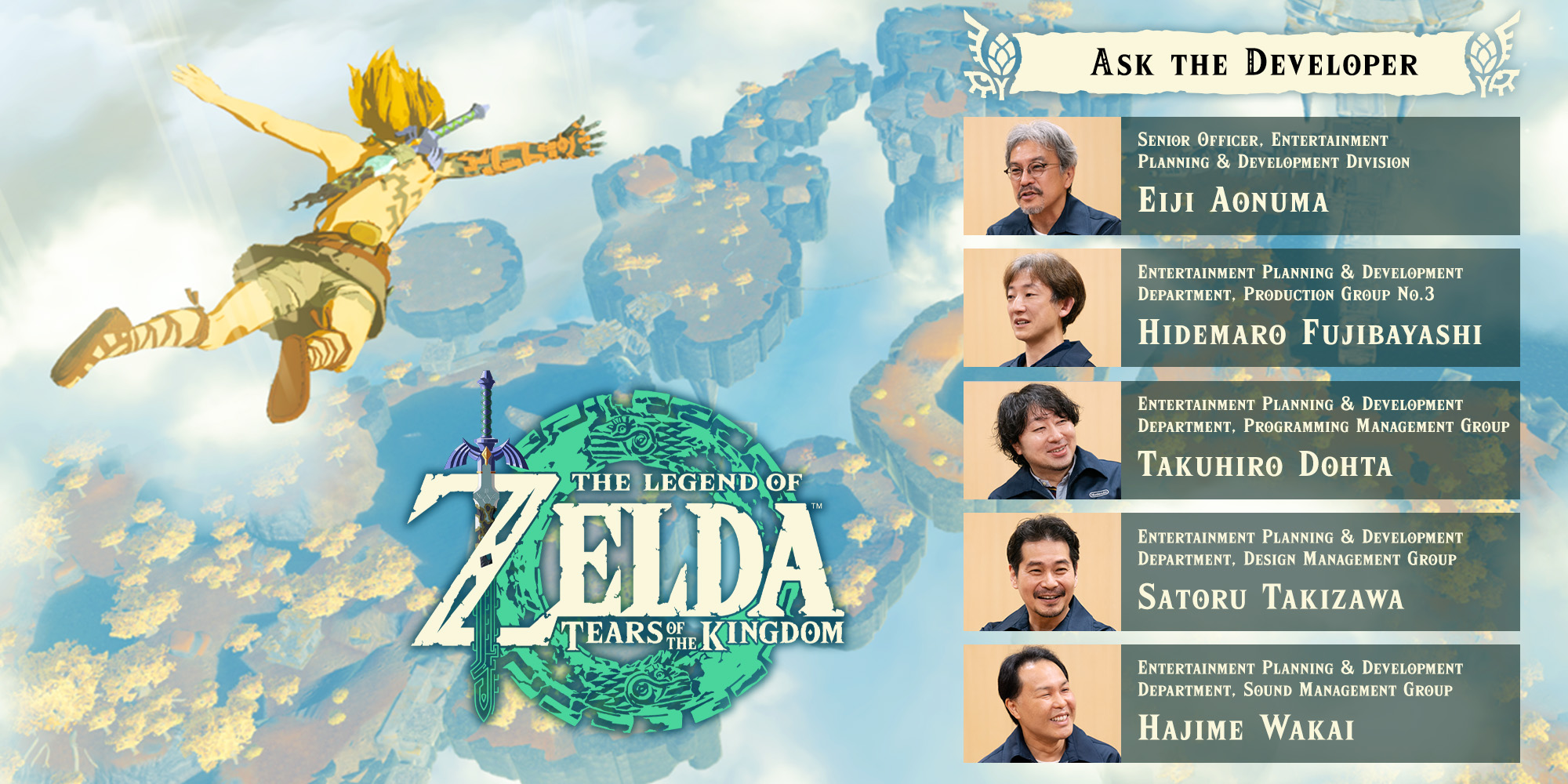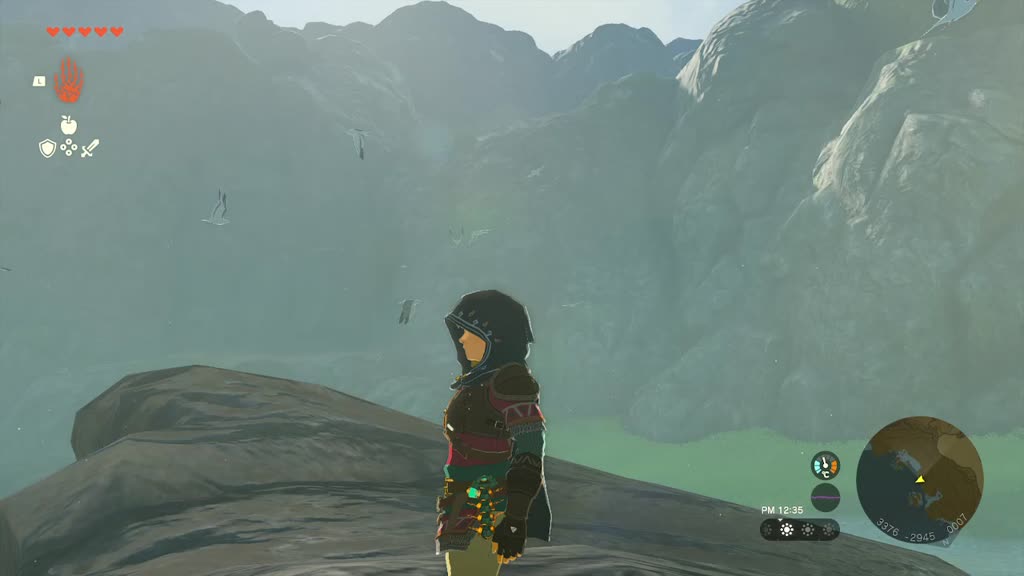Ask the Developer Vol. 9, The Legend of Zelda: Tears of the Kingdom – Chapter 1
09/05/2023

Some of the images and videos shown in text were created during development.
This article has been translated from the original Japanese content.
In this ninth volume of Ask the Developer, an interview series in which Nintendo developers convey in their own words Nintendo’s thoughts about creating products and the specific points they are particular about, we’re talking to the developers behind The Legend of Zelda: Tears of the Kingdom for Nintendo Switch, which launches on Friday, May 12th.
Chapter 1: What to change, and what to keep
First, could I ask you to briefly introduce yourselves?
Aonuma:
Hello, I’m Eiji Aonuma, the producer of The Legend of Zelda series. My first role in the series was designing dungeons for The Legend of Zelda: Ocarina of Time (1). I served as the director and producer for The Legend of Zelda: Twilight Princess (2), and I’ve been the series' producer ever since.
(1) The Legend of Zelda: Ocarina of Time. Released in December 1998 for Nintendo 64. It is characterised by a story that goes back and forth between Link's childhood and adulthood.
(2) The Legend of Zelda: Twilight Princess. Released in December 2006 for Wii and Nintendo GameCube. In the Twilight Realm, the world of shadow, Link transforms into a wolf.
Fujibayashi:
Hello, I’m Hidemaro Fujibayashi, The Legend of Zelda: Tears of the Kingdom's director. Continuing from The Legend of Zelda: Skyward Sword (3) and the previous game, The Legend of Zelda: Breath of the Wild (4), I proposed the fundamental idea of the game and directed the entire production team.
(3) The Legend of Zelda: Skyward Sword. Released in November 2011 on Wii. This game featured an intuitive control system which utilised the technology of the Wii Remote Plus and Wii MotionPlus accessories. A remaster of the game, The Legend of Zelda: Skyward Sword HD, was released in July 2021 for Nintendo Switch.
(4) The Legend of Zelda: Breath of the Wild. Released for Nintendo Switch and Wii U in March 2017. Awakening from a 100-year slumber, the protagonist, Link, must explore and survive the vast and dangerous land of Hyrule to regain his memories. The Legend of Zelda: Tears of the Kingdom is its direct sequel.
Dohta:
Hi, I’m Takuhiro Dohta, the technical director for this game. I've been involved in the Legend of Zelda series in various different roles, but The Legend of Zelda: Breath of the Wild was the first time I worked on a Legend of Zelda game from the very start. In this title too, I was responsible for the game's overall technical direction.
Takizawa:
Hi, I’m Satoru Takizawa, the art director for this game. I first joined the series with The Legend of Zelda: Ocarina of Time, and since then, I’ve been handling artwork and design for titles such as The Legend of Zelda: The Wind Waker (5) and The Legend of Zelda: Twilight Princess. I've coordinated the visuals since The Legend of Zelda: Breath of the Wild.
(5) The Legend of Zelda: The Wind Waker. Launched in May 2003 for Nintendo GameCube. The player controls the wind with a mysterious baton to sail across the ocean and explore the different islands.
Wakai:
Hello, I’m Hajime Wakai, the sound director. My first involvement in the series was when I composed music for The Legend of Zelda: The Wind Waker. I’ve been involved as the sound director for the series since The Legend of Zelda: Skyward Sword.
Thank you very much. Many may already be familiar, but, Aonuma-san, could you give us a brief introduction to the Legend of the Zelda series?
Aonuma:
Of course. The Legend of Zelda series is set in the kingdom of Hyrule, where the sacred power of goddesses resides. It is a series featuring both action and puzzle solving, in which the protagonist Link, the player's avatar, battles against Ganondorf and others who are scheming to obtain that power. In many games, Link must also help Princess Zelda who is destined to be endowed with the sacred power of goddesses. This title, The Legend of Zelda: Tears of the Kingdom, is a direct sequel to The Legend of Zelda: Breath of the Wild, which released in 2017. Once again, it takes place in the vast land of Hyrule after the conclusion of the previous game.
So this title picks up after the events of The Legend of Zelda: Breath of the Wild.
Aonuma:
Yes, this title is set in Hyrule shortly after the end of the previous game. There are many reasons why we chose this setting. After finishing development on the previous title, we wondered if we could make it possible for players to continue exploring the world after they've reached the game's ending.
The Legend of Zelda series seems to be one of those franchises where the visual style and game mechanics often change drastically for each entry. Was there ever a discussion about creating a new game with a completely new world rather than a sequel?
Aonuma:
No, not really. Although the previous title, The Legend of Zelda: Breath of the Wild, has its own conclusion, we started to come up with new ideas that we wanted to bring to life in this already realised version of Hyrule, so our direction in making a sequel did not change.

Fujibayashi:
Just like somewhere you know inside and out, we understand where everything is in Hyrule from The Legend of Zelda: Breath of the Wild, and because of that, we believed it was possible to create new gameplay. For this reason, in the initial proposal, we clearly stated "the setting will not change" as an important concept. Even when I shared this with the team members here, there were no objections, and we were all aligned on that idea from that point onward.
Dohta:
When I was working on the programming for Wuhu Island during Wii Sports Resort's development (6), I remembered Miyamoto-san saying that he wanted to “turn the actual stages of games into characters". What he meant by that was to create one island and use that as a base to add various kinds of gameplay in different games. The idea of having new discoveries in the same setting was striking to me. I'd been wanting to try this idea with other titles, and I supposed this game would leverage that kind of approach.
(6) Wii Sports Resort. Released in July 2009 on Wii. Set on the tropical resort, Wuhu Island, the game offers 12 activities such as Swordplay and Air Sports.
I see. So the decision to create a sequel in the same setting was deliberate.
Dohta:
Yes. In contrast, we made some fairly big changes to the gameplay. In The Legend of Zelda: Skyward Sword, if players wanted to travel from the sky to the ground, they had to select it from the map, but in this game, you can dive from the sky directly to the ground without any interruption. On top of that, players can also ride on flying vehicles and so on, offering even more freedom within the same setting as the previous game. If a location were completely unfamiliar to you, you'd probably be hesitant to dive down from the sky, but because it’s a world that you’ve already explored in the previous game, these transportation methods make sense.
Being able to dive from the sky to the surface and into a pond seamlessly in this title sure does feel exhilarating. It truly feels like an open-air game this time around.
Dohta:
Adding the ability to dive from the sky was also partly due to Aonuma-san and Fujibayashi-san's persistence, right? (Laughs)
Fujibayashi:
Yeah. I’ve wanted to make this happen ever since The Legend of Zelda: Skyward Sword. Thinking how satisfying it'd be to dive from the sky and jump directly into the water. In this title, diving is not just about enjoying an exhilarating, seamless means of travel, but it also brings more value as a tool for gathering infomation about the surface by surveying it from above.
That's true. It's not just a satisfying way to travel. (Laughs) So you're saying that being able to look over Hyrule from above and descend from the sky further expands the scope of the gameplay, right?
Aonuma:
That’s right. But when we talk about these things, many may think, “Well, you can’t enjoy this game unless you've already played the previous game and are familiar with the setting". But the new gameplay ideas we packed into this title are all things that can be solved intuitively, so I think first-time players can rest assured that this game is easy to get into.
Fujibayashi:
The same goes for the story too. We put in some effort to make sure that it feels comfortable for both first-time players and those with experience of the previous game. For example, we’ve prepared a Character Profile feature that players can see anytime during their adventure, so it's easy to understand the relationship between characters, even without knowledge from the previous title. On the other hand, those who have played the previous game may enjoy reading these profiles, because some of the content will make you grin and think, “Right, I remember that”.

Since this is a sequel, The Legend of Zelda: Breath of the Wild is the foundation, but I see there are also various considerations for new players as well. By the way, if you're using the same world, don't you need to put effort into creating differences in the graphics and sound?
Takizawa:
I keenly felt that implementing something new into the same world was actually harder than creating something from scratch. Although it is the same world, we want to make sure players experience it with a new sense of wonder. So to achieve that, we had to take a world originally made up of things we'd designed to fit it perfectly, and then bolt a new layer of surprises on top of it, designed from a different perspective. And we had to do so without erasing the familiar world. Even though we racked our brains last time to put it all together! (Laughs) Of course from the development staff's point of view, it’s definitely more fun to come up with ideas for creating new surprises, but it sure was a challenging development process.
Wakai:
For the game's music, we broke the conventions of the series in the previous game and mainly used piano tones. While this title follows the same musical direction, we grappled with how to create a sense of freshness as a sequel. The sound effects are generated by a completely new system that's different from the previous game, so even if the same sound is used, it sounds a lot more realistic in this game. For example, in The Legend of Zelda: Breath of the Wild, we tried to make nearby environmental sounds, such as bird calls, sound realistic. However, with this title, the expressiveness of these sounds has improved to the point where players hear a bird call from afar and sense the distance more realistically.
So with each element that you were responsible for, you took on new challenges while working with the previous title as a framework.
Fujibayashi:
What to change, and what to keep. We spent a lot of energy thinking about this.





